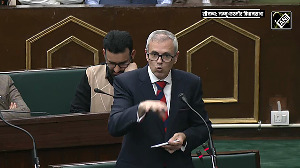Estimates suggest about $100 million has been poured into these companies and a lot more is still to come.

A few quirky-named companies such as ThePorter.in, TheKarrier, Trukky, Moovo.in and Letstransport have made it to many venture capitalists (VC)'s portfolio pages.
What differentiates these from others being funded by VCs is that these are logistics companies, evolving quickly and all set to go big.
Estimates suggest about $100 million has been poured into these companies and a lot more is still to come.
"There is a spike in the number of such companies…. With the advent of e-commerce sites, all products have to be delivered and hence the need for logistics-based services," said Pinaki Ranjan Mishra, partner and national leader - retail and consumer products practice - at EY.
 These companies, Mishra explained, can grow in scale quickly. "Traditional players find it difficult to match the agility of these players when time comes to expand the fleet in a big way."
These companies, Mishra explained, can grow in scale quickly. "Traditional players find it difficult to match the agility of these players when time comes to expand the fleet in a big way."
Investors say the moment had been arriving for three years and the inflection point was reached when e-commerce companies realised that relying on traditional trucking companies was expensive and their services were opaque.
"Another reason for such a huge uptake in web-led logistics companies is because of the success of the likes of Uber and Ola (cab aggregation services). There has been an evolution of that idea," said Pushkar Singh, CEO, Letstransport.in, a company operating in the space.
 The ease of buying smartphones has also contributed to start-ups attempting to disrupt the space as most companies are operating on the Uber model.
The ease of buying smartphones has also contributed to start-ups attempting to disrupt the space as most companies are operating on the Uber model.
"It has taken off in a big way in the past nine months because the penetration of mobile phones has increased," said Navin Honagudi, investment advisor, Kae Capital.
The early-stage venture invested in Theporter.in, which raised Rs 35 crore (Rs 350 million) in June.
This business-to-business, or B2B, company functions purely within city limits. It replicates the Uber model where small truck owners armed with phones accept orders and transport the goods from one end of the city to the other.

"There is an opportunity in this space, which is why there is so much activity. There are inefficiencies at every point in logistics currently. The one who can eliminate them can capture this market, which is why this is the golden period for logistics companies, not just last-mile deliveries," said Pranav Goel, co-founder, ThePorter.in.
The company tweaked its product to suit drivers and make it more intuitive. "We have colour-coded our app. It even generates an alarm telling the driver he may want to switch on his app to maximise his income," added Goel. What this does is create supply, so that companies never have to complain about non-availability of trucks.
These pushes have cheered customers and it has got companies ranging from Flipkart to HUL as well as local small and medium enterprises (SMEs) such as hardware manufacturers as clients.
The transparency in pricing has also encouraged SMEs to opt for these services.

Letstransport.in, powered by a $1.3-million investment from Japanese venture capital firm Rebright Partners, also on a variation of the Uber-model, has already partnered with about 100 companies including ITC, Coca Cola and SpoonJoy and plans to go into inter-city transport soon.
"The top 10 players just handle about 10 per cent of the market. So, the scope is tremendous and logistics as an industry will only get bigger. Our front-end is similar to Uber, but our back-end is much more complicated. It gives you a ride later option, which helps you book a truck a few days in the future," said Singh from Letstransport.in.
Like others, Letstransport is strictly operating in the intra-city space and believes the red-tape in the inter-city sector is not worth the trouble.
Analysts say logistics, independent of its recent online avatar, is worth $130 billion and almost $10 billion is the size of the market in the intra-city space.

Others such as Sastabhada.com are trying to crack the inter-city sector and are using the marketplace and subscription model to find a way around the red-tape. They have tied up with infrastructure companies and have taken on their logistics needs.
However, there are too many players in the sector trying to organise it.
"It is a little fractured right now because plenty of players are jumping on the bandwagon but in the next year, they will all fade away or get absorbed by the bigger players," said Mishra of EY.
Honagudi of Kae Capital said: "When we invested in the company, there were 20 players. By the end of the cycle, there will be just two or three left."
While no player has figured out how to crack the sector yet, experts say the Redbus moment might not be too far.











 © 2025
© 2025